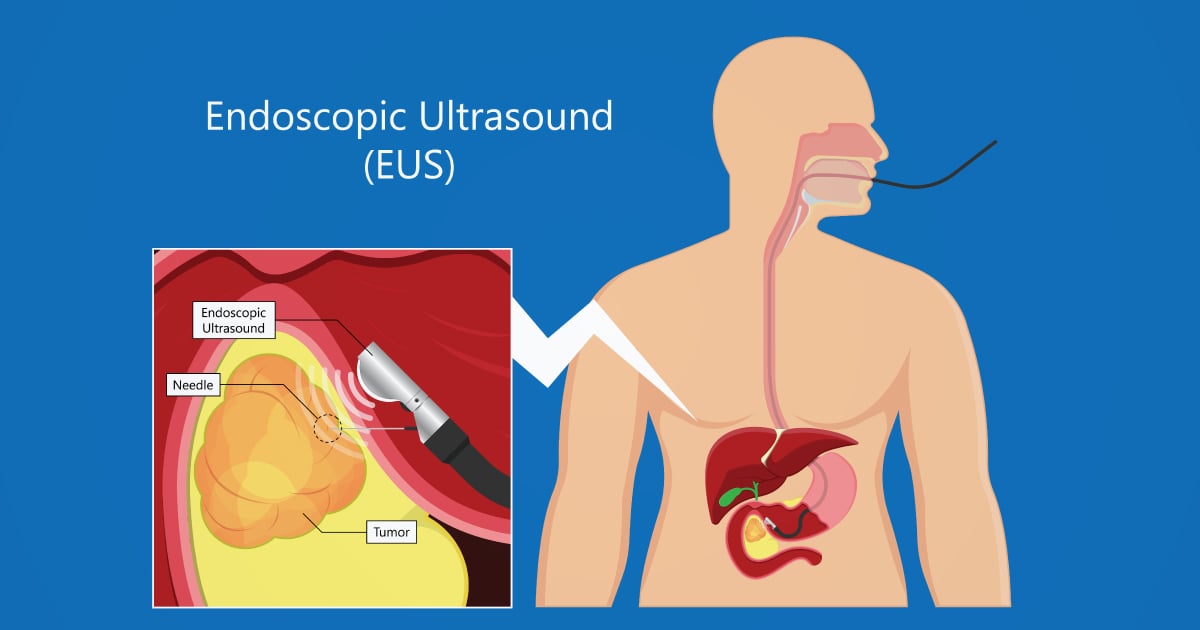Endoscopic ultrasound (EUS) is a procedure combining endoscopy and ultrasound to obtain images and information about the digestive tract and surrounding tissues and organs. It is used for various indications, including diagnosing and staging cancers, evaluating pancreatitis, and assessing bile duct conditions.
INDICATIONS
- Cancer staging: Particularly for esophageal, gastric, pancreatic, and rectal cancers.
- Assessment of pancreatic diseases: Including chronic pancreatitis and cysts.
- Biliary diseases: Evaluating bile duct stones or strictures.
- Submucosal lesions: Diagnosing tumors beneath the lining of the GI tract.
- Mediastinal lymph nodes: Evaluating nodes for diseases such as lymphoma or sarcoidosis.
BENEFITS
- Detailed imaging: Provides high – resolution images of the digestive tract and surrounding structures.
- Minimally invasive: Less invasive than surgical exploration, reducing recovery time and risk.
- Fine needle aspiration (FNA): Allows for biopsy of masses or lymph nodes for histopathological examination
- Accurate staging: Helps determine the extent of cancer spread, aiding in treatment planning.
- Guided drainage: Can assist in draining fluid collections or cysts in the pancreas or other areas.
RISKS
- Infection: Risk of infection at the biopsy site or within the digestive tract.
- Bleeding: Risk of bleeding from the biopsy site, especially in patients with clotting disorders or on blood thinners.
- Perforation: Rare risk of creating a hole in the GI tract or nearby organs.
- Pancreatitis: Risk of inflammation of the pancreas, particularly when evaluating pancreatic lesions.
Adverse reactions to sedation: Including respiratory depression or allergic reactions.
PREPARATION
- Fasting: Patients are typically required to fast for at least 6 – 8 hours before the procedure.
- Medication adjustments: Blood thinners and certain other medications may need to be adjusted or paused.
- Consent: Informed consent is obtained, detailing the procedure, benefits, and risks.
- Pre – procedure assessment: Includes reviewing medical history, allergies, and previous reactions to sedation or anesthesia.
DURING THE PROCEDURE
- Sedation: Patients are usually sedated to ensure comfort. This can involve conscious sedation or, in some cases, general anesthesia.
- Positioning: The patient will be positioned on their left side.
- Endoscope insertion: The endoscope is inserted through the mouth and gently advanced through the digestive tract.
- Ultrasound imaging: Ultrasound waves are used to create detailed images of the digestive organs and surrounding structures.
- Biopsy (if needed): Fine needle aspiration or biopsy may be performed to collect tissue samples.
POST – PROCEDURE
- Recovery: Patients are monitored until the effects of sedation wear off. This usually takes 1 – 2 hours.
- Diet: Initially, patients may need to start with clear liquids and gradually progress to a normal diet as tolerated.
- Activity: Avoid strenuous activities for the remainder of the day.
- Follow – up: Instructions on when to resume medications and other specific follow – up care will be provided.
- Complications: Patients are advised to seek medical attention if they experience severe abdominal pain, fever, vomiting, or signs of infection.
Endoscopic ultrasound is a valuable diagnostic and therapeutic tool with significant benefits in evaluating and managing various gastrointestinal conditions. While it carries certain risks, they are relatively low and manageable with proper preparation and post – procedure care.
Endoscopic ultrasound (EUS) Specialist
Dr. Aroon Siripun, Gastroenterology, GI and Liver Center, Bangkok Hospital
Hospital Specializes in Endoscopic ultrasound (EUS)
At Bangkok Hospital, our GI and Liver Center is ready to provide consultation about any gastrointestinal problems, diagnostic endoscopy, state-of-the-art treatment for your precious quality of life.
References:
- American Society for Gastrointestinal Endoscopy. (n.d.). “Understanding Endoscopic Ultrasound (EUS).” ASGE Patient Information
- Mayo Clinic. (n.d.). “Endoscopic Ultrasound.” Mayo Clinic











